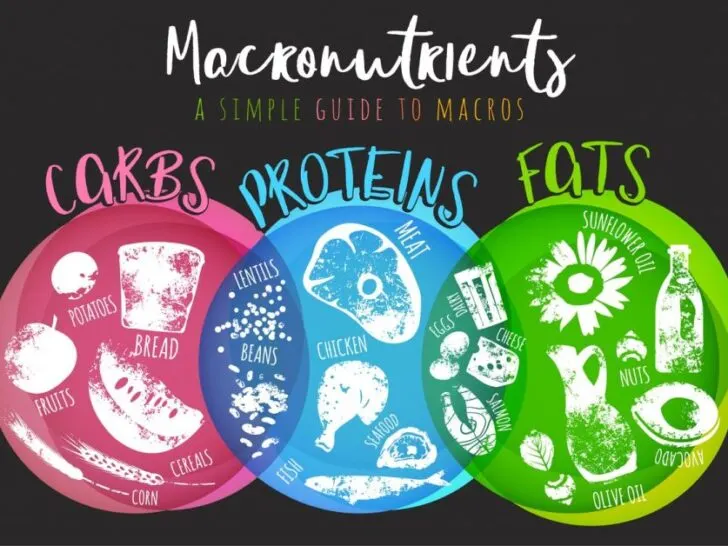Some of the links in this post are affiliate links. This means if you click on the link and purchase the item, we will receive an affiliate commission from the vendor at no extra cost to you. These business relationships allow us to keep bringing you great EatMoveHack content. All opinions remain our own.
Maintaining a healthy diet plan is more than counting calories. To indeed observe a balanced diet, you need to consume a variety of nutrients that nourish your body, give it energy, and helps your digestive system work correctly. The best way to keep tabs on your food choices, both to stay healthy and lose weight, is to track macronutrients with macro planning.
Counting macros over calories helps you make smart food choices. It also enables you to understand which food types make you feel good or bad, improve your energy levels, help you focus, make you drag, or allow you to lose weight. It can also help you shift your present eating patterns to healthy habits for the long term.
Want to lose weight, gain muscle, or feel more energized? Here is a blow by blow of what you need to know about macro diet planning, flexible dieting, and counting macros.
What Is the Macro Diet?
A macro diet is more than typical calorie counting. It requires you to count the macronutrients (grams of carbs, fats, and proteins) you are eating within your current diet plan, and in what ratios.
The macro diet has some similarities with other diet plans, such as Paleo or Caveman diet, because it emphasizes the essence of consuming whole foods over processed ones. It also shares a commonality with weight loss diets like EMH low-carb intermittent fasting diet and other calorie-counting nutrition plans since you have to track your daily intake and stay within particular ranges.
However, it differs from other diets because it does not follow a one-size-fits-all dieting approach. You start with a target ratio, say 50% carbs, 25% fat, and 25% protein. Then an online macro calculator, or your nutritionist, will assist you in determining your specific macro ratio based on things like your body type, goals, medical history, and activity level.
You target these macronutrient intake levels of protein, carbohydrates, and fats while still striving to achieve the proper intake of necessary vitamins and minerals.
You can later adjust your specific macro ratio based on your body’s reaction to the personalized meal plan.
What Are Macronutrients?
Macronutrients refer to the three primary nutrient building block categories that you eat most and provide most of your energy. They are:
- Carbohydrates: Complex carbohydrates give you sustained energy, and those high in dietary fiber promote digestive health. Sources for complex carbs include vegetables and fruits like leafy greens, root veggies, and whole grains. They have four calories per gram.
- Proteins: Help you grow, build muscle, and repair injuries. Choose fatty fish (mackerel, salmon, and herring), grass-fed beef, cod, nuts, turkey, etc. They also have four calories per gram.
- Fats: Dietary fats help you absorb fat-soluble vitamins, protects your organs, supports cell growth, induce hormone production, and insulate the body during cold weather. Sources include healthy fats such as oils (coconut, olive), avocado, nuts (macadamia, Brazil), almonds, etc. Generally, these types of fats have nine calories per gram. Don’t be afraid of saturated fats either, this is a hold-over from long-ago when we were told to only consume unsaturated fats. You should work hard to avoid trans fats as those are the really nasty fats that can cause long-term health problems.
It is best to stick to whole, fresh food rather than processed ones.
How Many Macros Should You Eat?
Every person is different, so there is no answer to this question. But for a start, you could try the following federal dietary recommendations:
- Carbohydrates: 45-65%
- Fats: 20-35%
- Proteins: 20-35%
That’s a wide range that covers different people with varying activity levels.
Your macro ratio will depend on your particular health and fitness goals and how you respond to specific foods. For instance, some people thrive on a low carb diet, while others prefer a high-protein diet.
How to Calculate Your Macros
It’s essential to learn how to calculate your macros, mainly because nutrition labels provide nutritional information in grams, but your intake ratios are in percentages. Let’s say, for example, your daily calorie goal is 2,300. To calculate your macros:
- Determine your calorie goal – in this case, 2,300.
- Determine your ideal ratio. For a start, take 50% carbs, 25% fats, and 25% protein.
- Multiply the total calories by your percentages.
- Finally, divide your macronutrient calorie amounts by its corresponding calorie-per-gram number.
Example:
- Carbs: 2,300 x 0.5 = 1,150 calories per day ÷ 4 (calories per gram) = 5 grams.
- Protein: 2,300 x 0.25 = 575 calories per day ÷ 4 (calories per gram) = 75 grams.
- Fats: 2,300 x 0.25 = 575 calories per day ÷ 9 (calories per gram) = 8 grams.
What About Macro Calculators and Macro Trackers?

A young woman looking at her fitness app after a run.
If you have no time for these planning processes, don’t fret. There are several meal planning apps and macronutrient calculators to sort you out.
A Macro calculator helps you calculate your macronutrient ratio based on several factors such as your age, height, gender, weight, activity level, and lifestyle. They include:
- IIFYM (If It Fits Your Macros)
- Healthy Eater
- Muscle for Life
Macro trackers, on the other hand, help you log your meals throughout the day and break down your macro ratio to make sure you eat according to your targets. These include:
Is There a Meal Plan to Help You Stick to Your Macros?
Yes, you can create your diet plan using macro planning, a macro calculator and tracker, and some online resources, such as this one. You can also talk to a nutritionist to help you come up with a nutrition plan to get started and then adjust it on the go.
You will need to use trial and error as you start a macro diet plan to adjust your daily macro ratio to meet your lifestyle, body type, and health goals.
Know Thyself
1. Counting Macros for Healthy Weight Loss
Ensure that you count your macros in a way that allows you to cut calories. For example, a sample range is 10-30% carbs, 40-50% protein, and 30-40% fat. Then adjust accordingly. For instance, if you are active or exercise daily, you can increase your carbs intake.
2. Counting Macros for Bodybuilding
Here, you want to add the number of overall calories to add weight and muscle. A sample range is 40-60% carbs, 25-35% protein, and 15-25% fat. It’s a common misconception that bodybuilders must overindulge on protein.
3. Counting Macros for Maintenance
You need to stick to the number of calories your body requires to sustain your present weight. A sample range is 30-50% carbs, 25-35% protein, and 25-35% fat.
4. Counting Macros for Low-Carb, High-Fat Weight Loss Plans
These diets include Keto or EMH Low-Carb Intermittent Fasting. You must consume the right macronutrient balance to ensure your body remains in ketosis and burns body fat effectively. A sample range is 5-10% carbs, 15-30% protein, and 60-75% fat.
Some Guiding Principles of Macro Dieting
- If you get hungry, consume more protein since it’s a satiating macronutrient. Fiber is also a filing food.
- When you tired, consume more fibrous veggies and carbs to ensure you get sufficient energy.
- If you are not losing weight as required, lower your carbs intake, especially at dinner.
- If you get sugar cravings, balance your blood sugar with protein and fiber. Remove all sugar from your diet.
- If you lose weight too fast, add some starch (maybe five to six bites of sweet potato, squash, or oatmeal). You can also add some protein per day and incorporate strength training into your workouts.
Over to You for Macro Planning
Using macro planning and counting to maintain a healthy weight and lifestyle is a good idea. The diet plan will keep you on track, ensure you chose healthy, balanced meals, and prevent you from having low energy or feeling starved. While it can be hectic at first, a good, balanced meal plan will help you stick to the macro diet.
Keep using your meal-planning apps as much as possible, at least until you get conversant with counting your macros. It will be tedious and time-consuming at first, but it’s excellent at keeping you on track. Besides, after a while, you will start making healthy, smart food choices. With persistence and diligence, you will meet your goals.
Hopefully, you have enjoyed the read and learned how to kick start your macro planning diet today. Check out some of our other information-dense posts on healthy lifestyles and diet plans, and stay tuned for more nutritional-focused posts coming soon.

